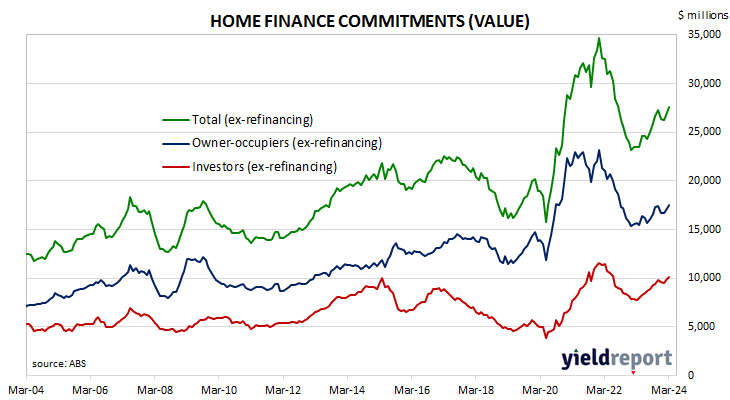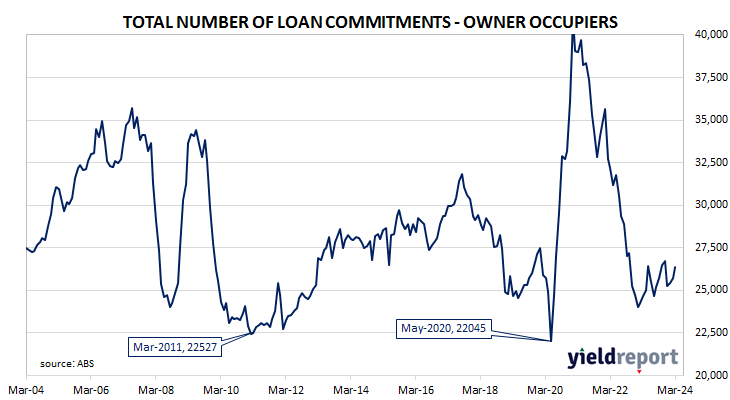Summary: Value of loan commitments up 3.1% in March, more than expected; 17.9% higher than March 2023; Westpac: to larger average loan sizes, investor activity becoming more-prominent driver of gains; ACGB yields down; cash rate expectations sending mixed messages; ANZ: likely to see loan sizes continue growing; value of owner-occupier loan approvals up 2.8%; investor approvals up 3.8%; number of owner-occupier home loan approvals up 2.4%.
The number and value of home-loan approvals began to noticeably increase after the RBA reduced its cash rate target in a series of cuts beginning in mid-2019, potentially ending the downtrend which had been in place since mid-2017. Figures from February through to May of 2020 provided an indication the downtrend was still intact but subsequent figures then pushed both back to record highs in 2021. However, there has been a considerable pullback since then, although the total value of new loans is still elevated by historical standards.
March’s housing finance figures have now been released and total loan approvals excluding refinancing increased by 3.1% In dollar terms over the month, more than the 1.0% rise which had been generally expected and up from February’s 1.9% increase after revisions. On a year-on-year basis, total approvals excluding refinancing were 17.9% higher than March 2023, up from the previous month’s comparable figure of 14.2%.
“Approvals have recovered strongly on a year ago, up 17.9% in value terms, although over half of this looks to be due to larger average loan sizes, for investor loans in particular,” said Westpac senior economist Matthew Hassan. “The detail also suggests investor activity is becoming a more prominent driver of gains, especially in WA but with the notable exception of Victoria.”
Commonwealth Government bond yields fell on the day, although not quite as much as the falls of US Treasury yields on Thursday night (AEST). By the close of business, 3-year and 10-year ACGB yields had both lost 3bps to 4.03% and 4.43% while the 20-year yield finished 1bp lower at 4.73%.
In the cash futures market, expectations regarding the cash rate changes over the next 12 months continued to send mixed messages. At the end of the day, contracts implied the cash rate would remain close to the current rate for the next few months and average 4.33% through May and 4.345% in June. However, November contracts implied a 4.41% average cash rate, February contracts implied 4.33%, while May 2025 contracts implied 4.22%.
“Positive real wage growth and tax cuts starting should see borrowing capacity rise, which combined with continued housing price growth, is likely to see loan sizes continue growing,” said ANZ senior economist Blair Chapman.
The total value of owner-occupier loan commitments excluding refinancing increased by 2.8%, up from February’s 1.5%. On an annual basis, owner-occupier loan commitments were 11.4% higher than in March 2023, up from February’s comparable figure of 9.3%.
The total value of investor commitments excluding refinancing increased by 3.8%. The rise follows a 2.5% increase in February, taking the growth rate over the previous 12 months from 23.8% to 31.1%.
The total number of loan commitments to owner-occupiers excluding refinancing increased by 2.4% to 26352 on a seasonally adjusted basis, up from the 1.5% increase in February. The annual growth rate accelerated from 5.9% after revisions to 6.8%.



